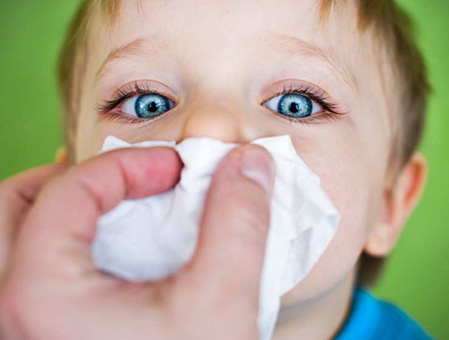Nosebleeds are bleeding from the tissues (nasal mucous membranes) inside the nose caused by a broken vessel.
Important points about nosebleeds
- Nosebleeds are bleeding from the tissues (nasal mucous membranes) inside the nose caused by a broken vessel.
- Nosebleeds may seem scary, but they're usually not a serious problem. Nosebleeds are common in children. They are more common in dry climates and are more common during the winter months.
- Nosebleeds can be caused by many things, including dry air, nosebleeds, and allergies. In most cases, no specific cause of nosebleeds is found.
- To help prevent nosebleeds, run a cool mist humidifier in your child's room at night if the air in your home is dry. Teach your child not to sniff or blow too hard. Apply Vaseline to your child's nostrils several times a day.
What causes nosebleeds in children?
Nosebleeds can be caused by many things. Some common causes are:
- dry air
- nose pick
- blowing the nose too hard
- nose injury
- Colds and allergies
- object in nose
In most cases, no specific cause of nosebleeds is found.
How are nosebleeds diagnosed and treated in children?
In diagnosing a nosebleed, your healthcare provider will ask about your child's symptoms and health history. He or she may also ask about recent accidents and injuries. He or she will perform a physical examination of your child.
Treatment for a nosebleed includes:
- Soothe and comfort your child
- Have your child sit up and lean forward slightly. Don't put your child to bed. This is to prevent him from swallowing blood. Swallowing blood can make your child vomit. Do not put your child's head between their knees. This can make the bleeding worse.
- Tell your child to breathe through their mouth. Gently pinch the nostrils for five to ten minutes. Do not stop the pinching to check if the bleeding has stopped.
- Apply a cold compress to the bridge of the nose. Do not put tissue or gauze on your child's nose.
- If the bleeding does not stop, repeat the above steps.
- After the bleeding has stopped, tell your child not to rub, pick, or blow their nose for two to three days. This will allow the broken blood vessel to heal.
If your child's nose doesn't stop bleeding, talk to a healthcare professional. In some cases, the provider may apply heat to close a blood vessel. This is called cauterization. It is a quick procedure. Talk to your child's healthcare provider about the risks, benefits, and possible side effects of all treatments.

 TR
TR DE
DE RU
RU




